2003一2013年湖北华中师范大学地理学科考研真题
地理考研真题
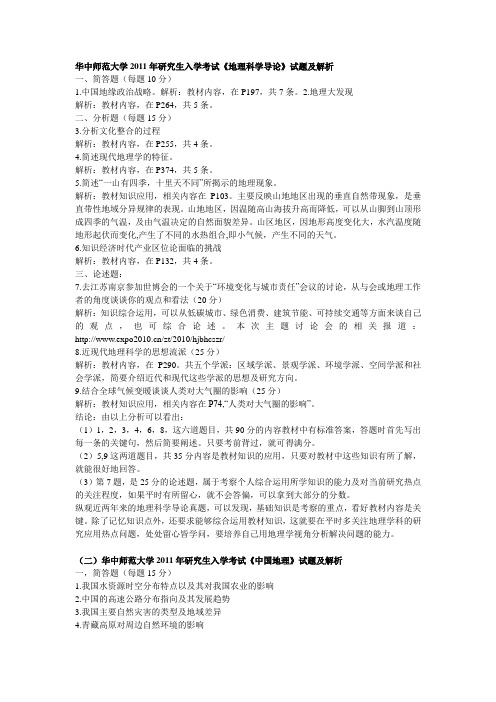
华中师范大学2011年研究生入学考试《地理科学导论》试题及解析一、简答题(每题10分)1.中国地缘政治战略。
解析:教材内容,在P197,共7条。
2.地理大发现解析:教材内容,在P264,共5条。
二、分析题(每题15分)3.分析文化整合的过程解析:教材内容,在P255,共4条。
4.简述现代地理学的特征。
解析:教材内容,在P374,共5条。
5.简述“一山有四季,十里天不同”所揭示的地理现象。
解析:教材知识应用,相关内容在P103。
主要反映山地地区出现的垂直自然带现象,是垂直带性地域分异规律的表现。
山地地区,因温随高山海拔升高而降低,可以从山脚到山顶形成四季的气温,及由气温决定的自然面貌差异。
山区地区,因地形高度变化大,水汽温度随地形起伏而变化,产生了不同的水热组合,即小气候,产生不同的天气。
6.知识经济时代产业区位论面临的挑战解析:教材内容,在P132,共4条。
三、论述题:7.去江苏南京参加世博会的一个关于“环境变化与城市责任”会议的讨论,从与会或地理工作者的角度谈谈你的观点和看法(20分)解析:知识综合运用,可以从低碳城市、绿色消费、建筑节能、可持续交通等方面来谈自己的观点,也可综合论述。
本次主题讨论会的相关报道:/zt/2010/hjbhcszr/8.近现代地理科学的思想流派(25分)解析:教材内容,在P290。
共五个学派:区域学派、景观学派、环境学派、空间学派和社会学派,简要介绍近代和现代这些学派的思想及研究方向。
9.结合全球气候变暖谈谈人类对大气圈的影响(25分)解析:教材知识应用,相关内容在P74,“人类对大气圈的影响”。
结论:由以上分析可以看出:(1)1,2,3,4,6,8,这六道题目,共90分的内容教材中有标准答案,答题时首先写出每一条的关键句,然后简要阐述。
只要考前背过,就可得满分。
(2)5,9这两道题目,共35分内容是教材知识的应用,只要对教材中这些知识有所了解,就能很好地回答。
(3)第7题,是25分的论述题,属于考察个人综合运用所学知识的能力及对当前研究热点的关注程度,如果平时有所留心,就不会答偏,可以拿到大部分的分数。
最新华中师范大学人文地理、自然地理学考研近18年真题
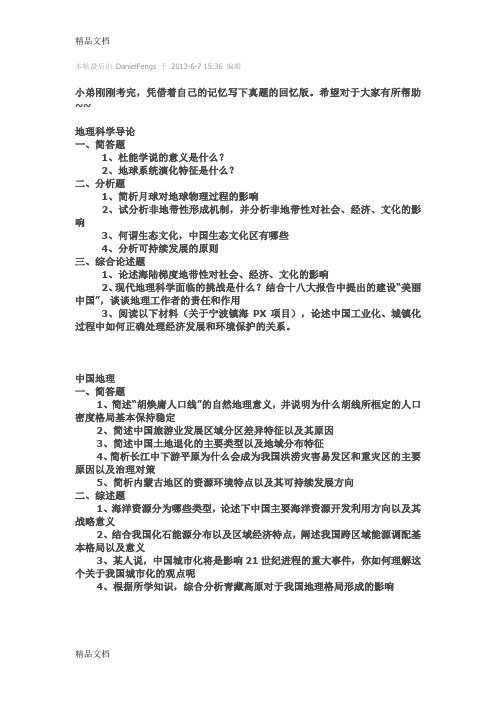
本帖最后由DanielFengs 于2013-6-7 15:36 编辑小弟刚刚考完,凭借着自己的记忆写下真题的回忆版。
希望对于大家有所帮助~~地理科学导论一、简答题1、杜能学说的意义是什么?2、地球系统演化特征是什么?二、分析题1、简析月球对地球物理过程的影响2、试分析非地带性形成机制,并分析非地带性对社会、经济、文化的影响3、何谓生态文化,中国生态文化区有哪些4、分析可持续发展的原则三、综合论述题1、论述海陆梯度地带性对社会、经济、文化的影响2、现代地理科学面临的挑战是什么?结合十八大报告中提出的建设“美丽中国”,谈谈地理工作者的责任和作用3、阅读以下材料(关于宁波镇海PX项目),论述中国工业化、城镇化过程中如何正确处理经济发展和环境保护的关系。
中国地理一、简答题1、简述“胡焕庸人口线”的自然地理意义,并说明为什么胡线所框定的人口密度格局基本保持稳定2、简述中国旅游业发展区域分区差异特征以及其原因3、简述中国土地退化的主要类型以及地域分布特征4、简析长江中下游平原为什么会成为我国洪涝灾害易发区和重灾区的主要原因以及治理对策5、简析内蒙古地区的资源环境特点以及其可持续发展方向二、综述题1、海洋资源分为哪些类型,论述下中国主要海洋资源开发利用方向以及其战略意义2、结合我国化石能源分布以及区域经济特点,阐述我国跨区域能源调配基本格局以及意义3、某人说,中国城市化将是影响21世纪进程的重大事件,你如何理解这个关于我国城市化的观点呢4、根据所学知识,综合分析青藏高原对于我国地理格局形成的影响地理科学导论一、概念题(每题10分,共30分)1.地质大循环2.(想不起来了,什么时候想起来随时补充)3.区位二、简答题(每题15分,共60分)1.开普勒行星运动三大定律及其意义2.共生理论的含义3.格尔德的“客观环境”与“行为环境”的区别?4.自然生态系统的纬度地带性规律及其成因三、论述题(每题20分,共60分)1.地理科学在生态文明建设和社会经济建设中的地位与作用?2.地球表层的含义、范围、基本特征和演化机制3.阅读下面的专栏,请结合材料分析现代文化与传统文化的特征及为什么既要保护传统文化又要发扬现代文化?(所谓专栏是一段材料,约1000多字,主要内容是传统节日的消亡、现代文化的兴起、屏幕时代以及与之相关的一系列高科技节日,比如“第一块电脑屏幕纪念日”,“第一封电子邮件发送纪念日”等,比较有深度,不过不影响答题)中国地理一、简答题(每题15分,共75分)1.中国的大地构造的特点及其对地貌格局的影响?2.长江中下游地区的地理特征?3.黄土高原水土流失的治理措施?4.新疆绿洲农业的特征、面临的问题及其治理办法?二、综合题(每题25分,共75分)1.请结合我国风沙的时空分布规律,分析京津风沙源治理工程的必要性及其意义2.结合我国植被碳密度和土壤碳密度的分布规律,分析我国的土地利用格局变化对全球气候变化的可能以前的年份,专业课《中国地理》的考试,每年区域部分都是考试重点。
考研_2003年湖北华中师范大学人文地理学考研真题

2003年湖北华中师范大学人文地理学考研真题
一、在概述人文地理学的本质属性与学科特性的根底上,论述人文地理学研究的四种主要方法论。
二、解析文化的构造,并论述文化的空间分布形态和时间扩散机制。
三、根据人口分布的影响因素和人口增长的动力机制,分析中国人口的分布特点和开展趋势。
四、概述可持续开展的由来背景,内涵实质,论述可持续开展与人文地理学研究的关系。
五、解释以下名词的定义及其特征。
1、现代农业
2、民族
3、民俗
4、语言
5、宗教
6、旅游资源
7、地理物象
8、国家核心区城市内部
9、地域构造模型。
2003年华中师范大学地理学基础考研试题(回忆版)
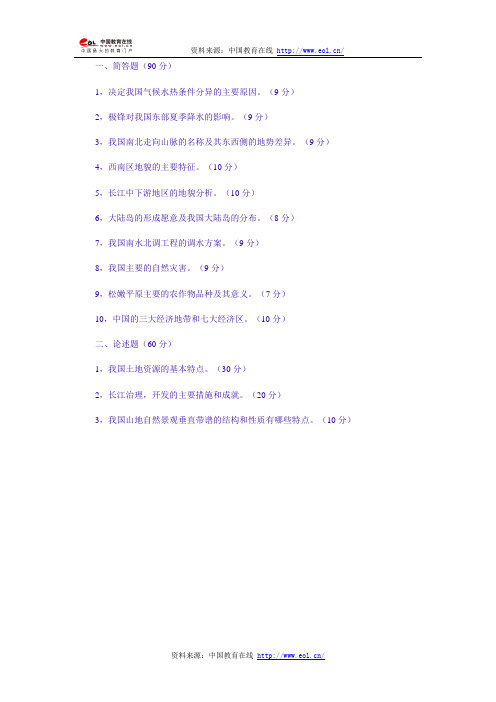
资料来源:中国教育在线 /
资料来源:中国教育在线 / 一、简答题(90分)
1,决定我国气候水热条件分异的主要原因。
(9分)
2,极锋对我国东部夏季降水的影响。
(9分)
3,我国南北走向山脉的名称及其东西侧的地势差异。
(9分) 4,西南区地貌的主要特征。
(10分)
5,长江中下游地区的地貌分析。
(10分)
6,大陆岛的形成愿意及我国大陆岛的分布。
(8分)
7,我国南水北调工程的调水方案。
(9分)
8,我国主要的自然灾害。
(9分)
9,松嫩平原主要的农作物品种及其意义。
(7分)
10,中国的三大经济地带和七大经济区。
(10分)
二、论述题(60分)
1,我国土地资源的基本特点。
(30分)
2,长江治理,开发的主要措施和成就。
(20分)
3,我国山地自然景观垂直带谱的结构和性质有哪些特点。
(10分)。
中国地理(考研资料)华中师范大学(完整版)
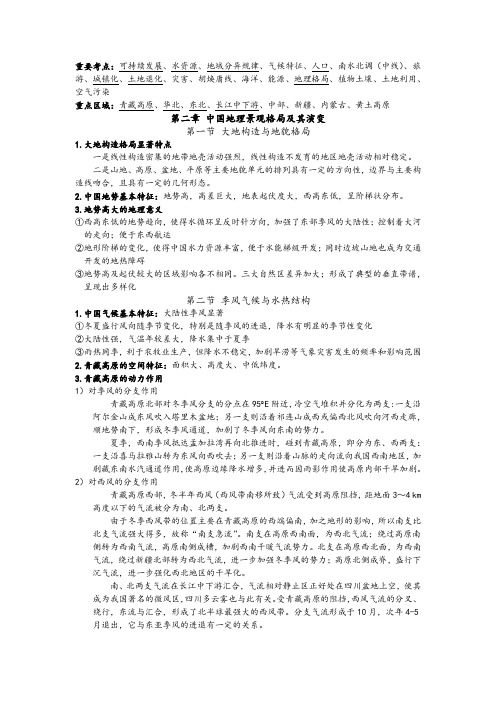
重要考点:可持续发展、水资源、地域分异规律、气候特征、人口、南水北调(中线)、旅游、城镇化、土地退化、灾害、胡焕庸线、海洋、能源、地理格局、植物土壤、土地利用、空气污染重点区域:青藏高原、华北、东北、长江中下游、中部、新疆、内蒙古、黄土高原第二章中国地理景观格局及其演变第一节大地构造与地貌格局1.大地构造格局显著特点一是线性构造密集的地带地壳活动强烈,线性构造不发育的地区地壳活动相对稳定。
二是山地、高原、盆地、平原等主要地貌单元的排列具有一定的方向性,边界与主要构造线吻合,且具有一定的几何形态。
2.中国地势基本特征:地势高,高差巨大,地表起伏度大,西高东低,呈阶梯状分布。
3.地势高大的地理意义①西高东低的地势趋向,使得水循环呈反时针方向,加强了东部季风的大陆性;控制着大河的走向;便于东西航运②地形阶梯的变化,使得中国水力资源丰富,便于水能梯级开发;同时边坡山地也成为交通开发的地热障碍③地势高及起伏较大的区域影响各不相同。
三大自然区差异加大;形成了典型的垂直带谱,呈现出多样化第二节季风气候与水热结构1.中国气候基本特征:大陆性季风显著①冬夏盛行风向随季节变化,特别是随季风的进退,降水有明显的季节性变化②大陆性强,气温年较差大,降水集中于夏季③雨热同季,利于农牧业生产,但降水不稳定,加剧旱涝等气象灾害发生的频率和影响范围2.青藏高原的空间特征:面积大、高度大、中低纬度。
3.青藏高原的动力作用1)对季风的分支作用青藏高原北部对冬季风分支的分点在95 E附近,冷空气堆积并分化为两支:一支沿阿尔金山成东风吹入塔里木盆地;另一支则沿着祁连山成西或偏西北风吹向河西走廊,顺地势南下,形成冬季风通道,加剧了冬季风向东南的势力。
夏季,西南季风抵达孟加拉湾再向北推进时,碰到青藏高原,即分为东、西两支:一支沿喜马拉雅山转为东风向西吹去;另一支则沿着山脉的走向流向我国西南地区,加剧藏东南水汽通道作用,使高原边缘降水增多,并进而因雨影作用使高原内部干旱加剧。
中国地理(考研资料)华中师范大学
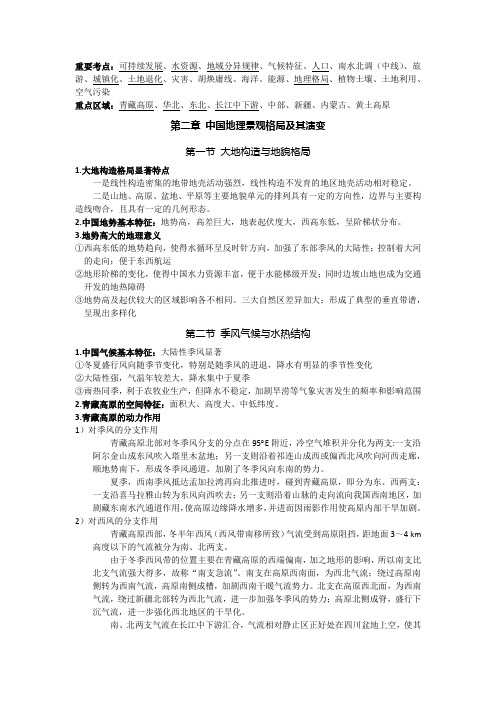
重要考点:可持续发展、水资源、地域分异规律、气候特征、人口、南水北调(中线)、旅游、城镇化、土地退化、灾害、胡焕庸线、海洋、能源、地理格局、植物土壤、土地利用、空气污染重点区域:青藏高原、华北、东北、长江中下游、中部、新疆、内蒙古、黄土高原第二章中国地理景观格局及其演变第一节大地构造与地貌格局1.大地构造格局显著特点一是线性构造密集的地带地壳活动强烈,线性构造不发育的地区地壳活动相对稳定。
二是山地、高原、盆地、平原等主要地貌单元的排列具有一定的方向性,边界与主要构造线吻合,且具有一定的几何形态。
2.中国地势基本特征:地势高,高差巨大,地表起伏度大,西高东低,呈阶梯状分布。
3.地势高大的地理意义①西高东低的地势趋向,使得水循环呈反时针方向,加强了东部季风的大陆性;控制着大河的走向;便于东西航运②地形阶梯的变化,使得中国水力资源丰富,便于水能梯级开发;同时边坡山地也成为交通开发的地热障碍③地势高及起伏较大的区域影响各不相同。
三大自然区差异加大;形成了典型的垂直带谱,呈现出多样化第二节季风气候与水热结构1.中国气候基本特征:大陆性季风显著①冬夏盛行风向随季节变化,特别是随季风的进退,降水有明显的季节性变化②大陆性强,气温年较差大,降水集中于夏季③雨热同季,利于农牧业生产,但降水不稳定,加剧旱涝等气象灾害发生的频率和影响范围2.青藏高原的空间特征:面积大、高度大、中低纬度。
3.青藏高原的动力作用1)对季风的分支作用青藏高原北部对冬季风分支的分点在95 E附近,冷空气堆积并分化为两支:一支沿阿尔金山成东风吹入塔里木盆地;另一支则沿着祁连山成西或偏西北风吹向河西走廊,顺地势南下,形成冬季风通道,加剧了冬季风向东南的势力。
夏季,西南季风抵达孟加拉湾再向北推进时,碰到青藏高原,即分为东、西两支:一支沿喜马拉雅山转为东风向西吹去;另一支则沿着山脉的走向流向我国西南地区,加剧藏东南水汽通道作用,使高原边缘降水增多,并进而因雨影作用使高原内部干旱加剧。
2004年湖北华中师范大学人文地理学考研真题

2004年湖北华中师范大学人文地理学考研真题
一、在概述人文地理学的学科特性的基础上,论述现代人文地理学发展的主要特征及其形成原因。
(30分)
二、城市的形成与自然环境有着密切的关系,请分别论述城市布局与地理区位,交通条件,自然环境的关系。
(30分)
三、什么是行为空间?人类日常活动有多种类型的行为空间,请分别论述这些行为空间的主要特征。
(30分)
四、为什么说可持续发展研究是人文地理学研究的重要任务?人文地理学应该怎样开展可持续发展领域的研究?(30分)
五、简答下列名词(每题3分,共30分)
1、人文地理学
2、行为地理学
3、文化景观
4、环境感知
5、可持续发展
6、适度人口
7、聚落
8、旅游目的地
9、旅游动机
10、国家权力。
2004年湖北华中师范大学地理学基础考研真题
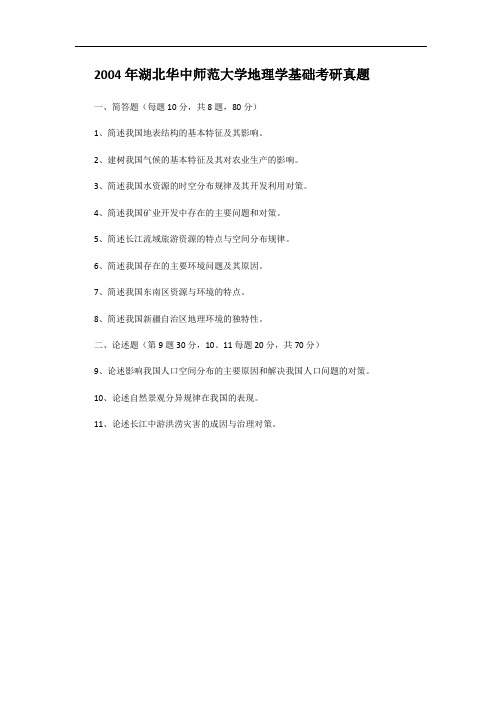
2004年湖北华中师范大学地理学基础考研真题
一、简答题(每题10分,共8题,80分)
1、简述我国地表结构的基本特征及其影响。
2、建树我国气候的基本特征及其对农业生产的影响。
3、简述我国水资源的时空分布规律及其开发利用对策。
4、简述我国矿业开发中存在的主要问题和对策。
5、简述长江流域旅游资源的特点与空间分布规律。
6、简述我国存在的主要环境问题及其原因。
7、简述我国东南区资源与环境的特点。
8、简述我国新疆自治区地理环境的独特性。
二、论述题(第9题30分,10、11每题20分,共70分)
9、论述影响我国人口空间分布的主要原因和解决我国人口问题的对策。
10、论述自然景观分异规律在我国的表现。
11、论述长江中游洪涝灾害的成因与治理对策。
华中师范大学人文地理学地理学基础试题

华中师范大学华中师范大学2002年考研试题人文地理学一、名词解释(20)1、客家方言2、通勤行为空间3、胡涣庸线4、制度文化二、简答1、简述城市地域结构形成的动力机制(15)2、简述旅游对区域文化的影响(15)3、简述中国人口增长转变模式及其成因(20)三、论述区域竞争力的构成及其提升途径(30)华中师范大学2003年考研试题人文地理学一,在概述人文地理学的本质属性与学科特性的基础上,论述人文地理学研究的四种主要方法论.(30分)二,解析文化的结构,并论述文化的空间分布形态和时间扩散机制.(30分)三,根据人口分布的影响因素和人口增长的动力机制,分析中国人口的分布特点和发展趋势.(30分)四,概述可持续发展的由来背景,内涵实质,论述可持续发展与人文地理学研究的关系.(30分)五,解释下列名词的定义及其特征.(9题,共30分)现代农业(3分) 民族(3分) 民俗(3分) 语言(3分) 宗教(3分)旅游资源(3分) 地理物象(3分) 国家核心区(3分) 城市内部地域结构模型(6分)华中师范大学2004年考研试题人文地理学一,在概述人文地理学的学科特性的基础上,论述现代人文地理学发展的主要特征及其形成原因.(30分)二,城市的形成与自然环境有着密切的关系,请分别论述城市布局与地理区位,交通条件,自然环境的关系.(30分)三,什么是行为空间?人类日常活动有多种类型的行为空间,请分别论述这些行为空间的主要特征.(30分)四,为什么说可持续发展研究是人文地理学研究的重要任务?人文地理学应该怎样开展可持续发展领域的研究?(30分)五,简答下列名词(每题3分,共30分)人文地理学行为地理学文化景观环境感知可持续发展适度人口聚落旅游目的地旅游动机国家权力华中师范大学2005年考研试题人文地理学一,任何学科的发展都离不开哲学方法论的指导,请结合人文地理学的发展分别对人文地理学研究的主要哲学方法论加以概述和评价.(30分)二,人地关系理论是人文地理学的核心理论,请从文化生态学的角度分别对人地关系的主要思想流派加以概述和评价.(30分)三,旅游业的发展在世界许多地区方兴未艾,请联系实际分别从经济,环境,社会,文化等方面说明旅游开发对旅游目的地区域的影响.(30分)四,可持续发展战略是引导我国未来发展的国家战略,服务社会是人文地理学这门经世致用之学的重要任务,你认为人文地理学应该怎样参与可持续发展战略的研究?请陈述你的观点.(30分)五,简述下列概念(每个3分,共30分)文化区域人口迁移适度人口地理人种民族特性城市体系地理物象行为空间国家核心区可持续发展华中师范大学2006年考研试题人文地理学1. 什么是人文地理学?人文地理学的学科特性,基本理论及哲学方法论.2. 什么是旅游地理?影响旅游决策的因素分析.3. 什么是行为地理?解释比较人们日常行为活动空间和人们迁移活动空间.4. 什么是政治地理?请分析政治地理要素及国家地理诸特征.5. 什么是可持续发展?阐述科学发展观,建构和谐社会和推行可持续发展的关系.华中师范大学2003年地理学基础试题一,简答题(90分)1,决定我国气候水热条件分异的主要原因.(9分)2,极锋对我国东部夏季降水的影响.(9分)3,我国南北走向山脉的名称及其东西侧的地势差异.(9分)4,西南区地貌的主要特征.(10分)5,长江中下游地区的地貌分析.(10分)6,大陆岛的形成愿意及我国大陆岛的分布.(8分)7,我国南水北调工程的调水方案.(9分)8,我国主要的自然灾害.(9分)9,松嫩平原主要的农作物品种及其意义.(7分)10,中国的三大经济地带和七大经济区.(10分)二,论述题(60分)1,我国土地资源的基本特点.(30分)2,长江治理,开发的主要措施和成就.(20分)3,我国山地自然景观垂直带谱的结构和性质有哪些特点.(10分)华中师范大学2004年地理学基础试题一,简答题(每题10分,共8题,80分)1,简述我国地表结构的基本特征及其影响.2,建树我国气候的基本特征及其对农业生产的影响.3,简述我国水资源的时空分布规律及其开发利用对策.4,简述我国矿业开发中存在的主要问题和对策.5,简述长江流域旅游资源的特点与空间分布规律.6,简述我国存在的主要环境问题及其原因.7,简述我国东南区(包括福建,广东,海南,台湾,香港和澳门)资源与环境的特点.8,简述我国新疆自治区地理环境的独特性.二,论述题(第9题30分,10,11每题20分,共70分)9,论述影响我国人口空间分布的主要原因和解决我国人口问题的对策.10,论述自然景观分异规律在我国的表现.11,论述长江中游洪涝灾害的成因与治理对策.华中师范大学2005年地理学基础试题一,简答题1,中国气候的基本特征.(8分)2,分析我国土地资源的基本特点.(12分)3,西南区的区域范围和地貌特征.(10分)二,论述题1,以我国东部湿润区为例,论述景观的地带性分异规律(30分)2,生物多样性保护的意义和方法.(30分)3,从人口,环境和发展的关系论述我国开展计划生育的意义和具体实施办法(30分)4,论述中国传统文化的主要特点,并概述其精华与糟粕之处(30分)华中师范大学2006年中国地理试题1.试述中国气候的基本特征.2.华北区水资源缺乏的表现,并提出解决措施.3.青藏区的气候特征.4.纬度地带性的主要表现.5.东北区的重工业基地主要有哪些?结合实际讲一下振兴东北老工业基地的现实意义.6.谈一谈长江流域的区域发展战略.华中师范大学2007年中国地理试题(部分)简答:1、中国人口的基本特点2、中国后备土地资源的特点3、东南区资源环境特征及评价4、旅游资源的类型结构论述:1、南水北调中线工程及可能产生的生态作用2、长江中下游沿江工业的发展,结构3、经济区?经济区划?类型,依据?中国七大经济区中,中央提出针对中部五省的“中部崛起”的战略意义。
华中师范大学人文地理学、自然地理学考研王静爱《中国地理教程》课后思考题答案
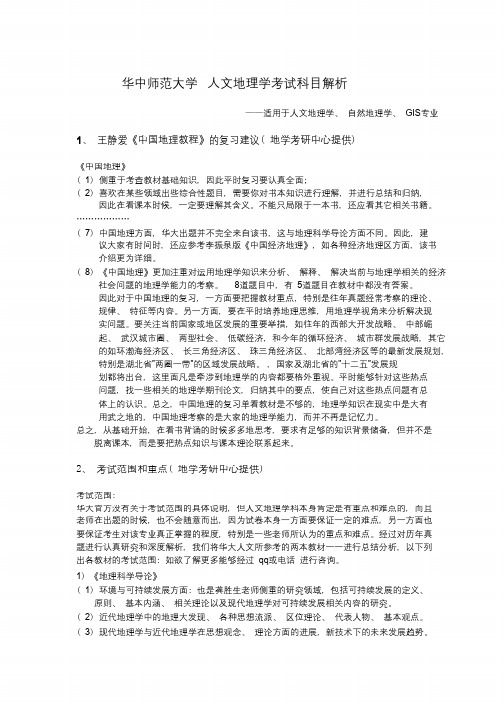
华中师范大学人文地理学考试科目解析——适用于人文地理学、自然地理学、GIS专业1、王静爱《中国地理教程》的复习建议( 地学考研中心提供)《中国地理》( 1) 侧重于考查教材基础知识, 因此平时复习要认真全面;( 2) 喜欢在某些领域出些综合性题目, 需要你对书本知识进行理解, 并进行总结和归纳, 因此在看课本时候, 一定要理解其含义。
不能只局限于一本书, 还应看其它相关书籍。
………………( 7) 中国地理方面, 华大出题并不完全来自该书, 这与地理科学导论方面不同。
因此, 建议大家有时间时, 还应参考李振泉版《中国经济地理》, 如各种经济地理区方面, 该书介绍更为详细。
( 8) 《中国地理》更加注重对运用地理学知识来分析、解释、解决当前与地理学相关的经济社会问题的地理学能力的考察。
8道题目中, 有5道题目在教材中都没有答案。
因此对于中国地理的复习, 一方面要把握教材重点, 特别是往年真题经常考察的理论、规律、特征等内容。
另一方面, 要在平时培养地理思维, 用地理学视角来分析解决现实问题。
要关注当前国家或地区发展的重要举措, 如往年的西部大开发战略、中部崛起、武汉城市圈、两型社会、低碳经济, 和今年的循环经济、城市群发展战略, 其它的如环渤海经济区、长三角经济区、珠三角经济区、北部湾经济区等的最新发展规划, 特别是湖北省”两圈一带”的区域发展战略。
, 国家及湖北省的”十二五”发展规划都将出台, 这里面凡是牵涉到地理学的内容都要格外重视。
平时能够针对这些热点问题, 找一些相关的地理学期刊论文, 归纳其中的要点, 使自己对这些热点问题有总体上的认识。
总之, 中国地理的复习单看教材是不够的, 地理学知识在现实中是大有用武之地的, 中国地理考察的是大家的地理学能力, 而并不再是记忆力。
总之, 从基础开始, 在看书背诵的时候多多地思考, 要求有足够的知识背景储备, 但并不是脱离课本, 而是要把热点知识与课本理论联系起来。
华中师范大学
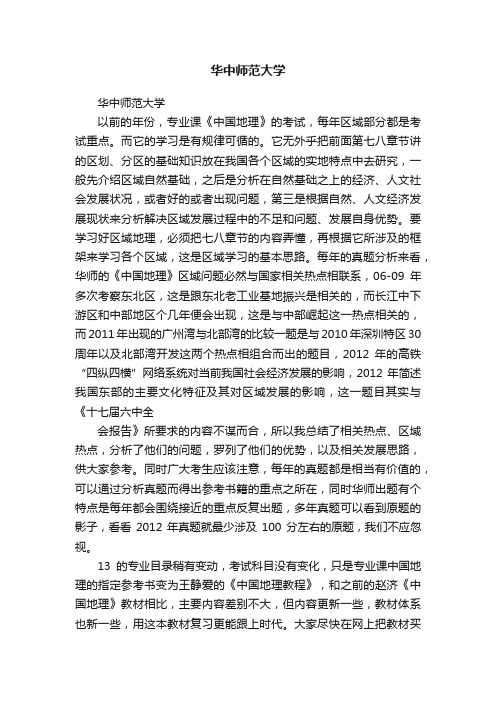
华中师范大学华中师范大学以前的年份,专业课《中国地理》的考试,每年区域部分都是考试重点。
而它的学习是有规律可循的。
它无外乎把前面第七八章节讲的区划、分区的基础知识放在我国各个区域的实地特点中去研究,一般先介绍区域自然基础,之后是分析在自然基础之上的经济、人文社会发展状况,或者好的或者出现问题,第三是根据自然、人文经济发展现状来分析解决区域发展过程中的不足和问题、发展自身优势。
要学习好区域地理,必须把七八章节的内容弄懂,再根据它所涉及的框架来学习各个区域,这是区域学习的基本思路。
每年的真题分析来看,华师的《中国地理》区域问题必然与国家相关热点相联系,06-09年多次考察东北区,这是跟东北老工业基地振兴是相关的,而长江中下游区和中部地区个几年便会出现,这是与中部崛起这一热点相关的,而2011年出现的广州湾与北部湾的比较一题是与2010年深圳特区30周年以及北部湾开发这两个热点相组合而出的题目,2012年的高铁“四纵四横”网络系统对当前我国社会经济发展的影响,2012年简述我国东部的主要文化特征及其对区域发展的影响,这一题目其实与《十七届六中全会报告》所要求的内容不谋而合,所以我总结了相关热点、区域热点,分析了他们的问题,罗列了他们的优势,以及相关发展思路,供大家参考。
同时广大考生应该注意,每年的真题都是相当有价值的,可以通过分析真题而得出参考书籍的重点之所在,同时华师出题有个特点是每年都会围绕接近的重点反复出题,多年真题可以看到原题的影子,看看2012年真题就最少涉及100分左右的原题,我们不应忽视。
13的专业目录稍有变动,考试科目没有变化,只是专业课中国地理的指定参考书变为王静爱的《中国地理教程》,和之前的赵济《中国地理》教材相比,主要内容差别不大,但内容更新一些,教材体系也新一些,用这本教材复习更能跟上时代。
大家尽快在网上把教材买到,熟悉一下内容,再把重要知识点整理出来,理解记忆,同时做些课外拓展,关注十八大相关信息。
华中师范大学 中国地理与地理科学导论历年真题2006-2013

精心整理华中师范大学2006年《中国地理》一、简答题:(共30分)1、简述青藏区的气候特点(15分)2、华北区水资源短缺的主要表现有哪些?你认为应该如何解决华北区的水资源的短缺问题二、论述题:(共120分)1、纬度地带性有哪些主要表现特征?2、中国气候的基本特征?(共30分)3、东北区的重工业基地主要有哪些?党中央提出的振兴东北区老工业基地的战略具有哪些现实意义?(共30分)4、试述长江中下游区的区域发展战略布局。
2007华中师范大学《中国地理》一、简答(本大题共60分,每小题15分)1、我国人口的基本特点。
2、北京经济发展的制约因素。
3、东南区的区域范围与资源、环境特点及简要评价。
4、我国后备耕地资源的分布特点。
二、综合题(本大题共90分,第6、7、8题,每题20分,第9题30分)5、试述南水北调中线工程的作用及其可能引起的环境效应。
6、试述我国风景旅游资源的类型结构和空间结构。
7、试述长江中下游区工业发展特点和主要工业基地建设。
8、试述经济区、经济区类型以及我国七大综合经济区中“中部五省经济区”的主要特点,并论述中央关于促进中部崛起战略的现实意义。
2008华中师范大学《中国地理》1.近百年来,我国气候变化趋势极其主要影响因素。
15’2.我国水资源与人口,耕地,矿产资源匹配组合特点。
15’3.区域规划含义,以及自然结构对生产力布局的影响。
15’4.长江中下游湖群分区以及水资源的主要特点。
15’5论述近年我国村镇建设的发展变化与今后建设发展目标。
30’6试分析长江中下游区区域发展条件,并论述本区主要生态问题和进行生态环境建设的基本策略30’7论述东北区的资源优势和东北区工农业基地建设30’2009华中师范大学城环院《中国地理》试题一、简答(本大题共60分,每小题15分1.中国的人文景观分布特点和空间特征。
2.谈谈你对振兴东北老工业基地的对策和思路。
3、晋陕内蒙古区土地退化原因及对策。
4.影响高新技术产业布局的因素和中国高新技术产业空间特征。
[华中师范大学]城环学院自然地理专业2003年硕士
![[华中师范大学]城环学院自然地理专业2003年硕士](https://img.taocdn.com/s3/m/c2fc473aba1aa8114431d965.png)
[华中师范大学]城环学院自然地理专业2003年硕士研究生复试试题一、地球运动有哪些地理意义?(16分)二、季风对我国东部降水有何影响?(16分)三、地球水循环与人类水资源供应有何联系?(16分)四、生态因子怎样影响生物种群增长?(16分)五、人类活动对地理环境变化有何影响?(16分)六、英译汉(20分)*注意:1 括号中系有下划线的词或短语对应的中文含义;2 人名(黑体)不必译成中文。
Ecological Economics and SustainabilityPerhaps the most salient(突出的,显著的) contribution of ecological economics is its challenge to many of the fundamental precepts(戒律,格言) of neoclassical(新古典主义的) economic theory. In the view advocated by ecological economists, an economyis a ‘one-way entropic throughput of energy and materials(耗散过程)’ as opposed to the neoclassical view of a circular flow of exchange value without any explicit links to the biophysical world. The central aim of ecological economics involves describing the relationship between ‘dynamic human economic systems and larger dynamic, but normally slower-changing ecological systems’。
- 1、下载文档前请自行甄别文档内容的完整性,平台不提供额外的编辑、内容补充、找答案等附加服务。
- 2、"仅部分预览"的文档,不可在线预览部分如存在完整性等问题,可反馈申请退款(可完整预览的文档不适用该条件!)。
- 3、如文档侵犯您的权益,请联系客服反馈,我们会尽快为您处理(人工客服工作时间:9:00-18:30)。
2003一2013年湖北华中师范大学地理学科考研真题
2003年湖北华中师范大学地理学科考研真题
一、论述题:每小题20分
1、运用地理课程理论,说明现行中学地理课程的基本特征,并结合当前进行的“地理课程改革”,谈谈你的认识;
2、以一节中学地理教材为例,说明编制中学地理教材应坚持的基本原则;
3、联系实际说明影响学生地理课堂学习动机的主要因素,并论述激发学习动机的基本策略;
4、自选一段中学地理教材内容,设计3种或3种以上的教学策略,并说明设计思想(理由)。
二、专业外语(英译汉): 满分20分
Water Pollution
Everybody needs fresh water. Without water people, animals and plants cannot live. Although a few plants and animals can make do with saltwater, all humans need a constant supply of fresh water if they are to stay fit and healthy. Of the total supply of water on the Earth, only about 3 percent of it is fresh, and most of that is stored as ice and snow at the poles, or is so deep under the surface of the Earth that we cannot get to it. Despite so much of the water being out of reach, we still have a million cubic miles of it that we can use. That's about 4,300,000 cubic kilometers of fresh water to share out between most of the plants, animals and people on the planet.
Whether water is clean enough to use, or too polluted depends on many things such as where it is, whether there is enough for everyone to use, what we do with it, and how we deal with the water we have used before we let it run back to join the rivers and lakes.
The Developing World
In the developing world the biggest problem is the shortage of water and the lack of clean supplies. When water is very scarce people have to make good use of it. That might mean using the same source of water for drinking and cooking, a place to wash, a place to clean clothing, pots and pans and a place to let the farm animals drink as well.
The same water is used by many people for many different purposes, and each time the water becomes a little more polluted.
Imagine a river that is the only source of water for a series of farming villages along its banks.
The people in the first village might be very careful and always get their drinking water from above the village, do all their washing a little further down stream, and let their animals drink in the river as it leaves their village. By being very careful and aware of basic hygiene they can try to stay healthy. They can do very little to protect themselves from dead animals decaying in the river further upstream, or from germs and parasites introduced to the water by wild animals. As the river leaves their village the water will have been polluted by washed bodies, food scraps from washed pots and pans, and body waste from the farm animals and village dwellers. The people in the next village will have to drink this polluted water, and will suffer from the diseases that accompany dirty water.
If an animal dies and falls into the only water supply for miles around, the people still have to drink the water. If the water is thick with mud and snails, but is the only water within reach, people have to drink it. Whether the water source is a river, a lake or a well, the problems are similar throughout the developing world; little piped and sterilized water, and not enough water to go round means that the same source has to be used for everything, and the risk of pollution and disease is very high .
2013年湖北华中师范大学地理学科考研真题
地理科学导论:
一、简答题
1、杜能学说的意义是什么?
2、地球系统演化特征是什么?
二、分析题
1、简析月球对地球物理过程的影响
2、试分析非地带性形成机制,并分析非地带性对社会、经济、文化的影响
3、何谓生态文化,中国生态文化区有哪些
4、分析可持续发展的原则
三、综合论述题
1、论述海陆梯度地带性对社会、经济、文化的影响
2、现代地理科学面临的挑战是什么?结合十八大报告中提出的建设“美丽中国”,谈谈地理工作者的责任和作用
3、阅读以下材料(关于宁波镇海PX项目),论述中国工业化、城镇化过程中如何正确处理经济发展和环境保护的关系。
中国地理:
一、简答题
1、简述“胡焕庸人口线”的自然地理意义,并说明为什么胡线所框定的人口密度格局基本保持稳定
2、简述中国旅游业发展区域分区差异特征以及其原因
3、简述中国土地退化的主要类型以及地域分布特征
4、简析长江中下游平原为什么会成为我国洪涝灾害易发区和重灾区的主要原因以及治理对策
5、简析内蒙古地区的资源环境特点以及其可持续发展方向
二、综述题
1、海洋资源分为哪些类型,论述下中国主要海洋资源开发利用方向以及其战略意义
2、结合我国化石能源分布以及区域经济特点,阐述我国跨区域能源调配基本格局以及意义
3、某人说,中国城市化将是影响21世纪进程的重大事件,你如何理解这个关于我国城市化的观点呢
4、根据所学知识,综合分析青藏高原对于我国地理格局形成的影响。
